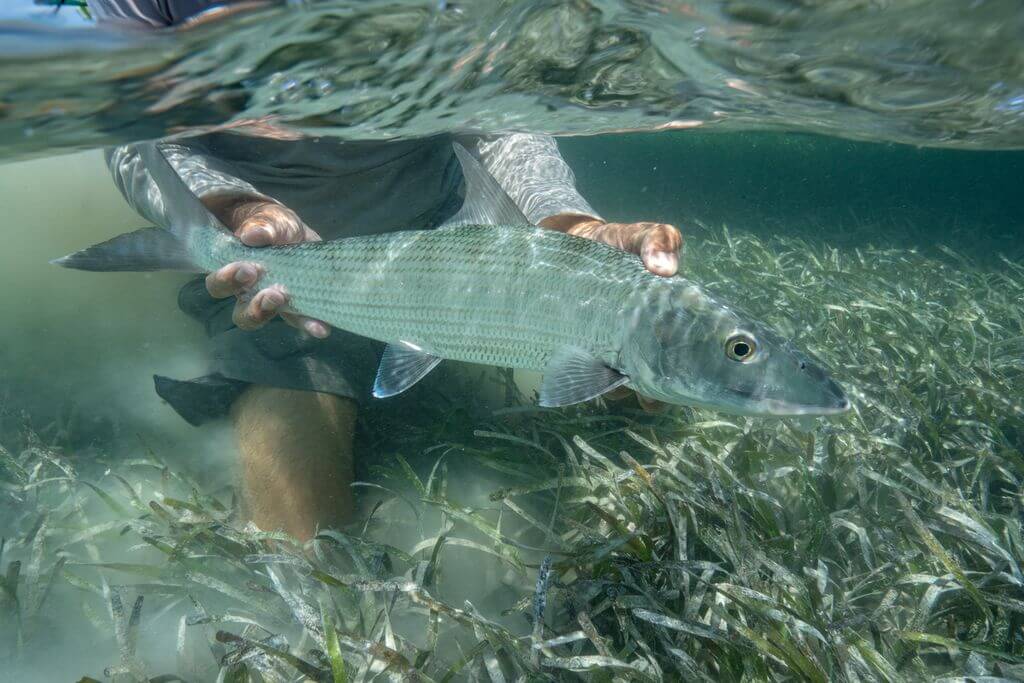
What’s so special about Bonefish Fishing in Belize? There may be no other inshore fish that inspires traveling anglers more than the wily bonefish. Landlocked fly fishers don’t hesitate to spend thousands of dollars to fly south to the shallow flats of the Caribbean to test their mettle against one of the most heralded bucket-list fish on the planet.
Bonefish are a challenging quarry, but they’re not impossible, like their flats-cruising cousin, the permit, often seems to be. Rather, bonefish are just challenging enough. They’ll make even a seasoned caster use all the tricks in the toolbox, and when a bonefish finally moves on a fly, there’s a magical split second of absolute relief mixed in with an exhilarating rush. Pound for pound, bonefish might be the strongest fish in the ocean.
And one of the best places anglers can visit to dependably see and catch bonefish is on the tropical flats of Belize when visiting Blue Bonefish Lodge.
Belize is a Bonefish Paradise
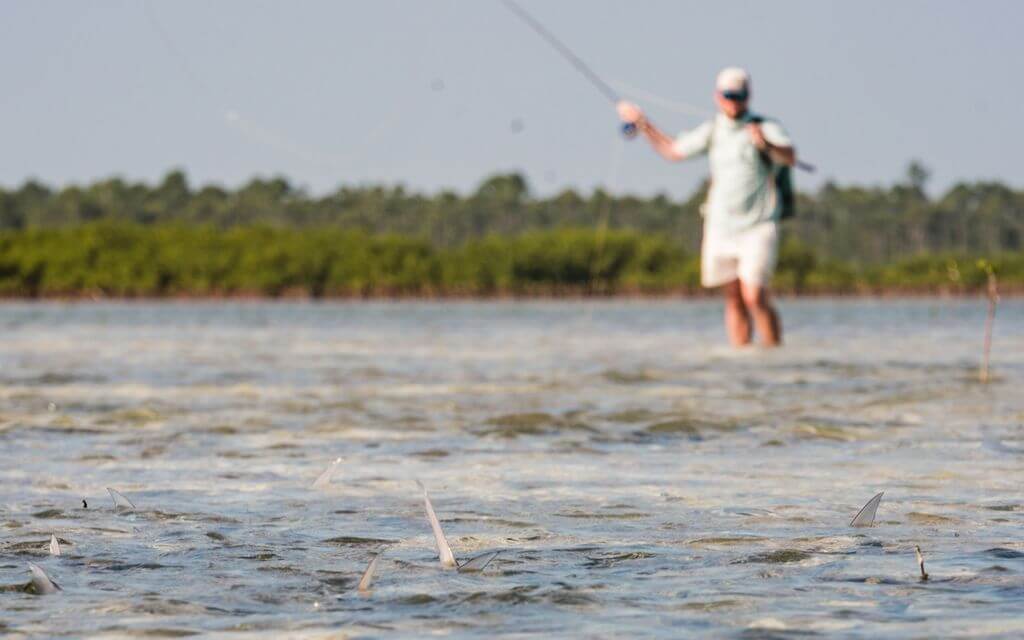
Belize is one of the most beautiful and welcoming countries in Central America, and it offers some of the best inshore fishing for everything from permit to tarpon. But its sand and grass flats make it possibly the best destination in the Caribbean for anglers who want to chase bonefish, the gray ghost of the flats.
With the help of a guide, and a homey and comfortable lodge, like Blue Bonefish Lodge in San Pedro on stunning Ambergris Cay, anglers can enjoy excellent angling for quality bonefish. Schools of bones are common, but the bigger fish — five-pounders and bigger — tend to peel off into groups of three or four. And Belizean guides are really good at finding these larger fish.
One of the reasons nearshore flats of Belize are so productive for bonefish is the quality of the habitat. Predictable tides, wadeable flats and miles upon miles of fishable water await die-hard bonefishers and complete newbies both. Belize does an admirable job caring for its fisheries, and the effort shows. If you’ve fished for bones elsewhere, but have yet to try your luck in Belize, you’re missing out.
Competent fly casters will find Belize’s bones to be challenging, yet accommodating — they aren’t heavily pressured fish, so they’re not super cautious, like some of the big bones that swim in the Florida Keys or on some of the more populated islands of the Bahamas. Rather, Belizean bones are inherently curious, and any good presentation — assuming the conditions are right — will earn a look. That look might be skeptical, or it might be exactly what the fishing fates ordered up.
But it’s still bonefishing. Anglers must take into account all the factors that accompany the pursuit of these noble fish. Very likely, there’ll be wind. Sometimes, the sun doesn’t penetrate the clouds. Both add layers of complexity to the pursuit of bonefish.
And, of course, any flats fishing for any inshore quarry requires a certain level of angling acumen. The average trout angler who rarely casts more than 30 feet of fly line might struggle mightily on the flats. The same holds true for anglers who are largely blind casters and aren’t used to the spot-and-stalk nature of flats fishing.
Becoming competent on the flats requires practice, and, while it’s always best to practice on the flats, it’s just as important to put in the time before making a trip to a country like Belize. Anglers should hone a few skills, like the double-haul cast, and they should put the cast to work in the wind and on the water. Arriving in Belize to chase bonefish without the skills to do it can make for a very frustrating week on the water.
Gear for Bonefish Fishing in Belize

At a minimum, anglers arriving to Belize to chase bonefish should come equipped with a 7-weight fly rod. For wind and larger fish, an 8-weight is an even better choice. Better yet, bring both, and pair each with a durable saltwater fly reel loaded with at 100 feet of floating saltwater fly line and at least 200 yards of 20-pound backing.
Fast-action fly rods are the name of the game when it comes to bonefish fishing in Belize, particularly in the wind. Seasoned anglers with flats experience can get by with moderate-action rods, but, as a rule, saltwater rods tend to be stiff and fast. And, because casts often have to be quite long, it takes a good cast to load and deliver a fly to a cruising bonefish.
In addition to dependable fly fishing tackle, anglers arriving to Belize should come equipped with good polarized sunglasses, a hat that shades the face and neck from the harmful rays of the sun and no small amount of sunscreen. Consider, too, a selection of face gaiters, sungloves, light-weight, quick-dry pants and long-sleeves sun hoodies.
Most lodges, like Blue Bonefish Lodge, will offer a detailed packing list, but the above-mentioned items should be considered necessities.
Flies For Bonefish Fishing in Belize

Flies sizes should range from size 8 on the small side to size 2 for larger patterns, like crabs or heavier shrimp patterns. There are literally dozens of quality bonefish patterns to choose from, but, for the most part, anglers in Belize can get by with a few choice flies.
Here are some patterns to consider for bonefish in Belize:
- Crazy Charlie: When it comes to Bonefish Fishing in Belize, this is perhaps the most common fly available, and, for fly tyers, it’s a simple pattern to tackle at the vise (Here is a great video tutorial). The Crazy Charlie imitates the small shrimp that tend to burrow into the sand and grass on the flats. Bonefish will often go out of their way to investigate a well-cast Crazy Charlie.
- Christmas Island Special: “Guide’s Favorite” for skinny water, lands soft and tied sparse.
- The Pink Puff: This fly is tied to imitate a small crab burdened by an egg sac. It can be an absolute killer pattern, and, like the Crazy Charlie, it’s easy to tie.
- The Gotcha: The Gotcha, like the Crazy Charlie, imitates a small shrimp. It’s generally tied with a bit more material than its cousin, and it’s often tied in larger sizes or with more weight for deeper water.
- Mantis Shrimp: This is a shrimp pattern that sports rubber legs and a set of mono “eyes” that extend off the bend in the hook. This is a good fly for water that might be a bit off-color due to wind or rain, because it moves water. The rubber legs make the fly easier for bonefish to see.
- Clouser Minnow. Yes, the ubiquitous baitfish pattern will work for hungry Belize bonefish, too.
Bonefish Techniques
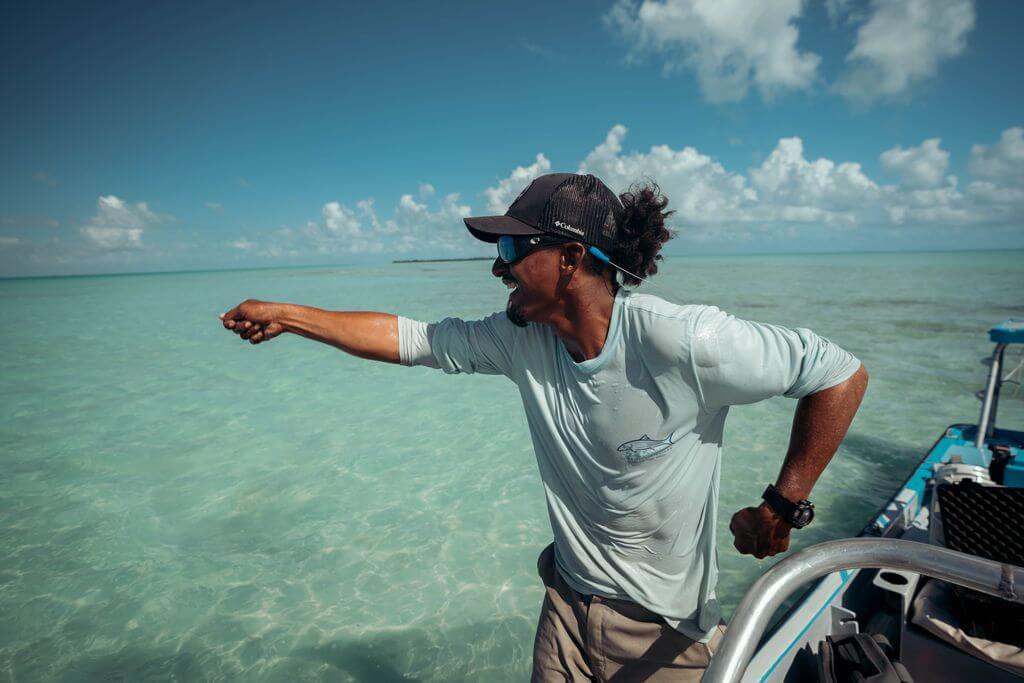
Fly fishing for bonefish in Belize is as hard as any angler makes it. Ill-equipped anglers are bound to struggle, and anglers who haven’t put in the time on the practice pond will require a day or so to shake off the rust.
But any angler who can dependably cast 40 or 50 feet of fly line, generally on target, can catch a bonefish in the shallow waters around Ambergris Cay. The best advice for these inexperienced flats fishers? Listen to the guide standing next to them, or, if they’re on the platform, give the guide their full attention. Follow instructions to the letter. One bonus? The official language of Belize is English, so there shouldn’t be any language barrier.
For more seasoned anglers who like to participate in the spotting and stalking process, the best approach is to always be prepared to make a long cast on target. With both the angler and the guide looking for fish, the chances of spotting one greatly improve.
Fishing From the boat

Once a bonefish, or a group of bonefish, is in the sights, things get interesting in a hurry. A good guide on the stern platform can spot a bonefish a couple of hundred yards out, and they’ll usually try and get the angler on the bow to see the fish, too, which makes their job much easier. Once both the guide and the angler have spotted the fish, things get interesting in a hurry.
It’s much easier to cast to bones from the bow of a boat. First, the angler on the bow is elevated, and it’s easier to see more of the water from a higher angle. It does come with a downside, however. The boat’s profile is larger, particularly with an angler in the bow and a guide on the stern platform. If bonefish get too close to you before they’re seen, they’ll most certainly see the boat and the two people on board trying to catch them. And they’ll vanish.
A good guide will position the boat to best serve an angler’s cast and give them the best possible angle. But there’s a lot of pressure on the angler to make a good cast and put the fly “in the zone” without spooking the fish.
It takes practice, and it’s easy to get discouraged. But every angler is different, and repetition is the key to eventual success. Once the cast is made, the real fun begins.
Any cast to a bonefish should be well out ahead of the fish. In words, an angler should “lead” the fish by casting several feet ahead — sometimes 10 feet or more for a cruising fish. A good guide will let an angler know if the cast is good, usually by saying something simple, like, “Leave it.” As the fish moves closer, the guide might say, “Strip.” If the fish moves on the fly, the guide will continue to coach the angler until the fish comes tight to the line.
Then comes the most important part. The guide will say, “Set.” Landlocked trout anglers will instinctively lift the rod and try to set the hook with the rod tip. This is a fatal mistake. Instead, bonefish, like most saltwater game fish, require a strip-set, meaning the angler must apply tension to the line by stripping line in and setting the hook.
Then, once the fish is well-hooked, the angler can raise the rod and fight the fish using the rod to temper the tension. One important tip: don’t put the hammer down right away — let the fish run. It may very well take all the fly line off of a reel and an angler might have to anxiously hope their backing knot is a good one. But this is what makes bonefishing so fun — these fish possess a life source that is, pound for pound, unmatched by any fish in the sea.
From the flats

One of the most rewarding experiences in all of fly fishing is catching a bonefish while wading the flats. Many die-hard bonefish anglers in Belize will only fish from the boat if the water’s too deep or the bottom is too mucky. Many simply prefer to be in the water where they can put their skills up against cruising fish.
And it can be a rush. But it’s also inherently more difficult.
First, the angler loses the advantage of elevation. The guide does, too. Second, longer casts are harder to make for anglers standing in knee-deep or thigh-deep water.
Simply put, walking and wading for bonefish requires more skill, more patience and even a bit more luck.
But it can be an absolute blast.
The first and most important tip for a successful wading adventure for bonefish is also likely the hardest to achieve: stealth.
Guides will caution anglers to move slowly and deliberately while wading for bones. One good rule of thumb. If an angler can hear water moving around their legs as they wade, they’re making too much noise.
Second, it’s very important to always be on the lookout for fish. Don’t blind cast and don’t get distracted. Guides will advise their clients to scan the water from about 10 to 40 feet out, and they’ll ask that anglers look for any movement or anything that looks fishy.
One good tip: Upon seeing something that might be a bonefish, point the rod at the object and keep the rod stationary. If the object moves, make a cast.
To that end, it’s advisable to keep about 40 feet of line off the reel. This means letting the fly line trail behind and the flats ahead are navigated. When it comes time to cast, there’ll be no need to pull line from the reel.
The casting, stripping, setting and fighting advice from above still holds. Let the fish run. Enjoy the battle. That’s why anglers chase bonefish to begin with.
Final word
Bonefish are one of the most challenging game fish for fly fishers. They’re smart, strong and fast. They have the ability to just disappear on a whim — they don’t call them the “gray ghost of the flats” for nothing.
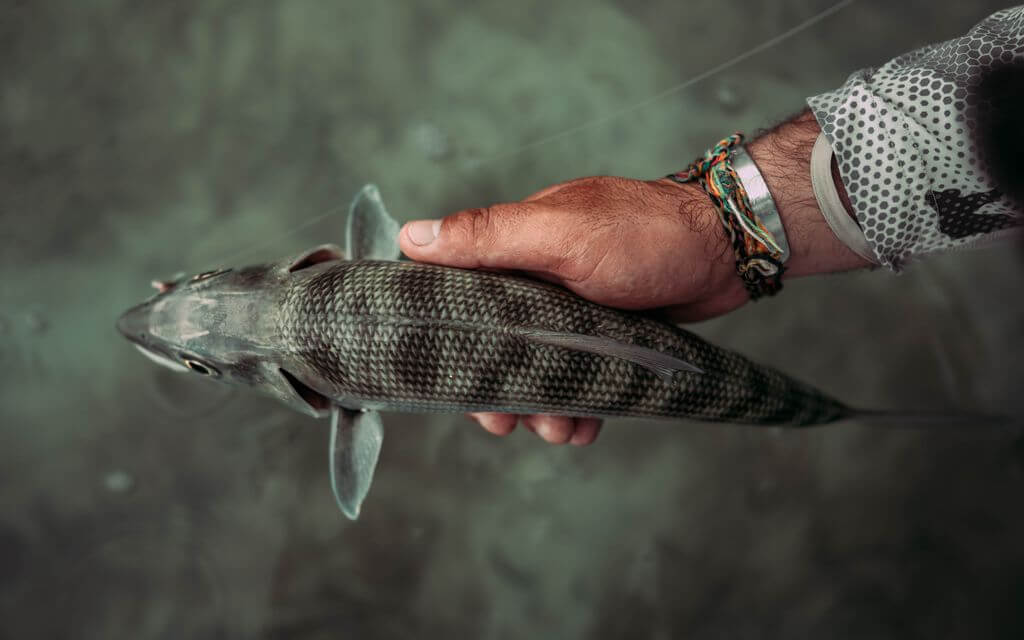
But catching them is perfectly doable, so long as an angler is patient and possesses the needed tools to put a fly on a small target, often in adverse conditions.
If you’re new to Bonefish Fishing in Belize, you should definitely hire a guide, or book a few days or even a week at a lodge like the Blue Bonefish. While there, they’ll get the needed tutelage from an experienced teacher and they’ll get to enjoy great Belizean hospitality.
Also, over the course of the week, anglers can literally watch as their skills get better. Daily casting will improve distance and accuracy, and even a missed shot at a bonefish can be a learning opportunity.
Remember, repetition breeds success, and it may take a couple of days to really dial in the bonefish discipline. But when that first fish comes tight and starts to fly off into the ether … that’s when the real hook is set.
That’s when a bonefisher is born.
Where to go Bonefish Fishing in Belize:
Blue Bonefish Lodge offers some of the best Bonefish, Permit, and overall salt water flats fishing offered South of the Equator. To book a stay at our beautiful lodge, Click HERE for details. We look forward to hosting you soon!
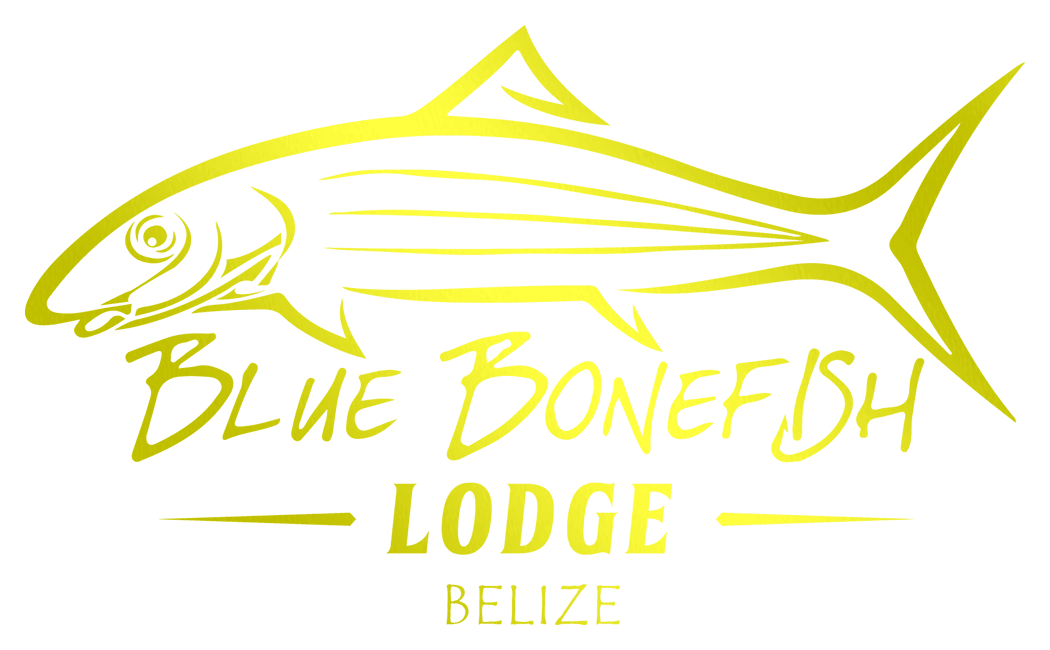
Recent Comments